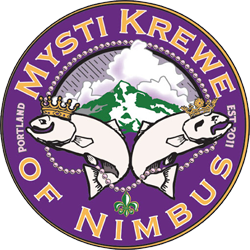Portland Mardi Gras Parade – February 13, 2024, N. Mississippi Avenue, Portland, OR (Last Mardi Gras Parade on the Planet)
Each year the Mysti Krewe of Nimbus hosts a free, family-friendly Mardi Gras parade for everyone. The parade steps off at 7:00 pm starting near Humboldt St and proceeds down Mississippi Avenue to Cook St., just past Fremont.
This community event invites all to dress up and come dance in the streets – joining the second line has become a rite of passage in Portland! Krewe members decorate signature mini-umbrella ‘throws’ to hand out to lucky participants.
Many venues along the way will have food and drink specials on parade day and things really get lively on Mardi Gras night, after the parade.
Take a look!
More about Mardi Gras Parades:
Different Parade Types:
1. Mardi Gras Parades – Louisiana and Gulf Coast
Actually, the first Mardi Gras parade in the U.S. didn’t take place in New Orleans. It was held in Mobile, Alabama (under French rule) in 1703. The tradition eventually marched down to New Orleans and today over 70 parades roll through the city every year during Mardi Gras season.
Each parade is run by a Krewe and has a theme, voted on by Krewe members. All floats are decorated to fit the theme. Krewe royalty and other members ride the floats and throw beads, doubloons and trinkets to people on the street. The biggest krewe parades roll the final few days before Fat Tuesday. They include the Krewes of Endymion, Bacchus, Zulu, and Rex. It takes almost an entire year to build the floats, so Krewes get started just days after the previous Mardi Gras has ended.
2. Second Lines – Jazz Funeral and/or Social Club
Second line parades are the descendants of New Orleans famed jazz funerals. Their roots go back to the 19th century to local fraternal societies that provided insurance and burial services, especially among the African American community. The “first line” is the main section of the parade, such as family members of the deceased in a funeral march, or members of a club with the parade permit. People who follow the main group and its band are called the “second line.”
Dozens of second line parades occur in New Orleans throughout the year, all over the city. Anyone can join in. Participants dance and strut in the street and often deck themselves out in brightly colored suits, sashes, and hats, while carrying parasols and banners. It has the spontaneous energy of a lively, moving block party.

